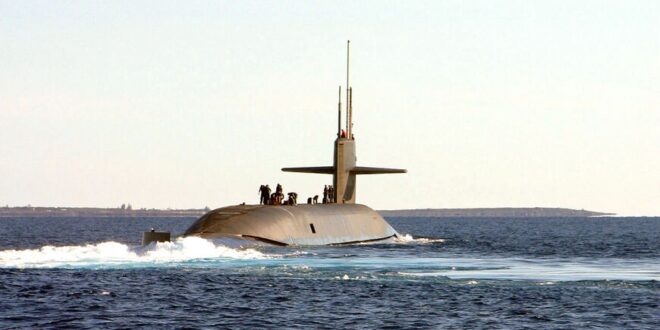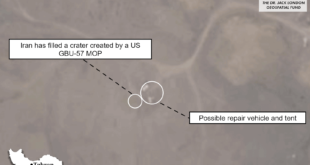The Ohio-class submarine is the latest in the Pentagon’s strike arsenal to arrive in the region amid a massive buildup of capabilities as Washington warns Iran and its proxies not to launch opportunistic attacks on Israel.
The Pentagon has dispatched an Ohio-class nuclear-powered submarine to Middle Eastern waters, the latest addition in a significant buildup of American and allied military forces in the region as Washington seeks to prevent Iran and its proxies from piling on Israel’s war in the Gaza Strip.
On Sunday US Central Command released imagery of the ship, which a spokesperson for the US Navy’s Fifth Fleet declined to identify. Open-source observers and Fox News suggested the vessel was the USS Florida, which is capable of carrying and delivering more than 150 Tomahawk cruise missiles and a Navy SEAL team.
Historically, the Pentagon has rarely disclosed the location of its missile submarines, but has made their presence in the Middle East known as tensions have grown with Iran in recent years.
The Florida was last reported to have passed through the Suez Canal into the Red Sea in April.
Why it matters: The submarine’s deployment is part of a wider buildup of US forces in the region designed to prevent Israel’s war from spreading into a regional conflagration.
Thus far, Iran’s proxies have avoided launching large-scale attacks to exploit the conflict.
But Washington’s show of force hasn’t stopped small-scale but nonetheless potentially lethal rocket and drone attacks on US troops in Iraq and Syria, which continued over the weekend, the Pentagon revealed on Monday.
US troops in Iraq and Syria were subjected to eight additional attacks since Friday, bringing the total to 38 separate attacks since Oct. 17, Pentagon press secretary Pat Ryder told reporters.
No new injuries resulted from the latest attacks, but the number of US personnel reporting signs of potential traumatic brain injuries in the aftermath of two prior attacks – one the Ain al-Asad air base in Iraq and the other at the Tanf garrison in Syria on Oct. 17-18 – has doubled since last week, Ryder said.
A total of 46 personnel have reported injuries from those two attacks, Ryder said. US troops have not reported any new injuries since Biden authorized retaliatory airstrikes on two facilities used by Iran’s Islamic Revolutuonary Guard Corps (IRGC) and groups it backs in eastern Syria on Oct. 26.
The Ohio-class sub joins two aircraft carrier strike groups led by the USS Ford and the USS Eisenhower, as well as additional fighter jets, the 26th Marine Expeditionary Unit and accompanying US Navy Amphibious Ready Group led by the USS Bataan.
The Bataan’s group is expected to remain in the Red Sea along with accompanying warships following a series of long-range missile attacks by Yemen’s Houthi rebels targeting Israel, in a historic first that has demonstrated the lethal range of militant groups armed and trained by Iran.
The US Air Force flew a B-1B bomber over Saudi Arabia on Sunday as the submarine transited Egypt’s Suez Canal.
What’s next: US officials hope the overwhelming display of force will continue to deter groups like Hezbollah from launching major attacks on Israel.
The IRGC’s Quds Force has built up a loose alliance of militias from Lebanon to Syria, Iraq and Yemen and armed them with lethal projectiles capable of overwhelming Israeli and other nations’ air defenses in the region.
US President Joe Biden has openly warned other actors not to exploit the conflict to launch their own attacks amid a myriad of recent public threats from groups like Kataib Hezbollah in Iraq and the Houthis in Yemen. Iranian officials have also issued public warnings that the region will “ignite” if Israel does not halt its war.
White House National Security Council coordinator John Kirby on Monday declined to provide further details about the Ohio-class submarine, but confirmed it had transited the Suez Canal.
“We will continue to adjust our force posture in the region to make sure we can a protect our troops and our facilities on the ground and be continue to send a strong deterrent message,” Kirby told reporters.
Know more: Neither the B-1B nor the Florida carry nuclear weapons but, combined with US surface vessels and fighter squadrons in the region, are capable of delivering overwhelming barrages of long-range strikes that could be devastating to both state and non-state actors.
Pentagon officials are walking a fine line, aiming to deter Iran’s network of proxies without escalating the situation into a regional war that could draw in US troops and strain the department’s strategy for deterring priority adversaries Russia and China.
US officials insist there are no plans to place US troops on the ground in Gaza amid Israel’s blistering bombardment and ground invasion, but US special operations forces have been working to gather intelligence on the more than 200 hostages believed to be held by Hamas and the Palestinian Islamic Jihad in the besieged enclave.
 Eurasia Press & News
Eurasia Press & News




